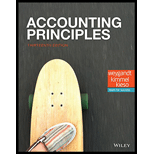
Concept explainers
a.
Concept Introduction:
Every business prepares four financial statements from the summarized accounting data, at the end of the accounting period. These financial statements include statements like an income statement that presents revenue, expenses, net income or loss, and a
The total assets on September 26, 2015 and on September 17, 2014 for Company A.
b.
Concept Introduction:
Every business prepares four financial statements from the summarized accounting data, at the end of the accounting period. These financial statements include statements like an income statement that presents revenue, expenses, net income or loss, and a balance sheet that shows the financial position of the company.
Cash and cash equivalents that Company “A” have on September 26, 2015.
c.
Concept Introduction:
Every business prepares four financial statements from the summarized accounting data, at the end of the accounting period. These financial statements include statements like an income statement that presents revenue, expenses, net income or loss, and a balance sheet that shows the financial position of the company.
The amount of account payable that company “A” reports on September 26, 2015 and September 17, 2014.
d.
Concept Introduction:
Every business prepares four financial statements from the summarized accounting data, at the end of the accounting period. These financial statements include statements like an income statement that presents revenue, expenses, and net income or loss, and a balance sheet that shows the financial position of the company.
The amount of net sales reported in 2013, 2014, and 2015.
e.
Concept Introduction:
Every business prepares four financial statements from the summarized accounting data, at the end of the accounting period. These financial statements include statements like an income statement that presents revenue, expenses, and net income or loss, and a balance sheet that shows the financial position of the company.
The amount of changes in A’s net income from 2014 to 2015.
Want to see the full answer?
Check out a sample textbook solution
Chapter 1 Solutions
EBK ACCOUNTING PRINCIPLES
- need help this questionsarrow_forwardSelected comparative financial statements of Korbin Company follow. Sales KORBIN COMPANY Comparative Income Statements For Years Ended December 31 2021 2020 $ 512,008 $ 392,240 2019 $ 272,200 Cost of goods sold 308,229 245,542 174,208 Gross profit 203,779 146,698 97,992 Selling expenses 72,705 54,129 35,930 Administrative expenses 46,081 34,517 22,593 Total expenses 118,786 88,646 58,523 Income before taxes .84,993 58,052 39,469 Income tax expense 15,809 11,901 8,012 Net income $ 69,184 $ 46,151 $ 31,457 KORBIN COMPANY Comparative Balance Sheets Assets Current assets Long-term investments Plant assets, net Total assets Liabilities and Equity Current liabilities Common stock Other paid-in capital Retained earnings December 31 2021 2020 2019 $ 54,370 0 $ 36,390 600 $ 48,645 3,870 99,436 90,776 53,339 Total liabilities and equity $ 153,806 $ 127,766 $ 105,854 $ 22,456 $ 19,037 $ 18,524 68,000 68,000 50,000 8,500 8,500 5,556 54,850 32,229 31,774 $ 153,806 $ 127,766 $ 105,854arrow_forwardprovide correct answer mearrow_forward
- general accountingarrow_forwardE3-17 (Algo) Calculating Equivalent Units, Unit Costs, and Cost Assigned (Weighted-Average Method) [LO 3-2] Vista Vacuum Company has the following production Information for the month of March. All materials are added at the beginning of the manufacturing process. Units . • Beginning Inventory of 3,500 units that are 100 percent complete for materials and 28 percent complete for conversion. 14,600 units started during the period. Ending Inventory of 4,200 units that are 14 percent complete for conversion. Manufacturing Costs Beginning Inventory was $20,500 ($10,100 materials and $10,400 conversion costs). Costs added during the month were $28,400 for materials and $51,500 for conversion ($26.700 labor and $24,800 applied overhead). Assume the company uses Weighted-Average Method. Required: 1. Calculate the number of equivalent units of production for materials and conversion for March. 2. Calculate the cost per equivalent unit for materials and conversion for March. 3. Determine the…arrow_forwardNonearrow_forward
- Principles of Accounting Volume 1AccountingISBN:9781947172685Author:OpenStaxPublisher:OpenStax College
 Intermediate Accounting: Reporting And AnalysisAccountingISBN:9781337788281Author:James M. Wahlen, Jefferson P. Jones, Donald PagachPublisher:Cengage Learning
Intermediate Accounting: Reporting And AnalysisAccountingISBN:9781337788281Author:James M. Wahlen, Jefferson P. Jones, Donald PagachPublisher:Cengage Learning EBK CONTEMPORARY FINANCIAL MANAGEMENTFinanceISBN:9781337514835Author:MOYERPublisher:CENGAGE LEARNING - CONSIGNMENT
EBK CONTEMPORARY FINANCIAL MANAGEMENTFinanceISBN:9781337514835Author:MOYERPublisher:CENGAGE LEARNING - CONSIGNMENT  Financial AccountingAccountingISBN:9781305088436Author:Carl Warren, Jim Reeve, Jonathan DuchacPublisher:Cengage Learning
Financial AccountingAccountingISBN:9781305088436Author:Carl Warren, Jim Reeve, Jonathan DuchacPublisher:Cengage Learning Financial Accounting: The Impact on Decision Make...AccountingISBN:9781305654174Author:Gary A. Porter, Curtis L. NortonPublisher:Cengage Learning
Financial Accounting: The Impact on Decision Make...AccountingISBN:9781305654174Author:Gary A. Porter, Curtis L. NortonPublisher:Cengage Learning Managerial AccountingAccountingISBN:9781337912020Author:Carl Warren, Ph.d. Cma William B. TaylerPublisher:South-Western College Pub
Managerial AccountingAccountingISBN:9781337912020Author:Carl Warren, Ph.d. Cma William B. TaylerPublisher:South-Western College Pub





